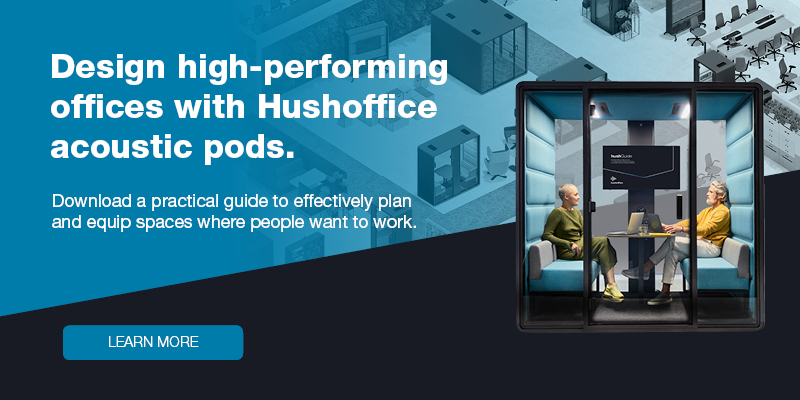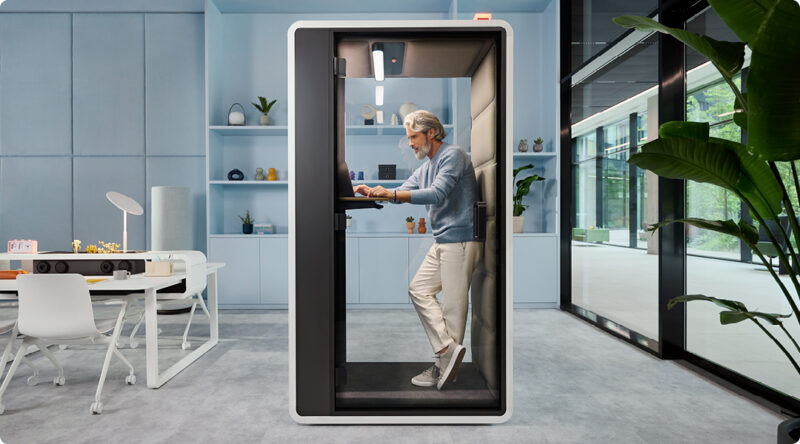The soundscape’s big role in office ergonomics
- Posted on: 8 July 2024
- By: Hushoffice Team
Good ergonomics means a harmonious fit between employees and their workspace. The cerebral piece of this puzzle? Sound. Melodic or dissonant, it produces or inhibits one’s pleasant hustle. With creative and concerted effort, acoustics can be tuned for excellence.
Office soundscape – tl;dr
Sound is integral to an office’s ergonomics, or the ease it affords employees while they perform each day. The psychoacoustics field indicates that soundscapes best promoting a mix of focused effort and mindful relaxation are partly biophilic, with a relatively steady background level, and some variability.
Most simply, the first step in improving a workplace’s acoustics is eliminating the noise that penetrates from outside. Here, treatments like secondary window glazes and sound-buffering landscaping are suited. Second comes the insulation of sounds made within. Solutions like noise-absorbing panels and upholsteries help on this front. Lastly, sound diffusers are a smart third step for teams who want to break up excess sound in select parts of the layout.
Office booths like the Hushoffice line are an awesome option for open spaces because they are self-contained work and meeting environments. Meticulously designed to give employees a premium, pleasantly quiet interior, they make deep focus and attentive collaboration more easily found on open floors. Moreover, they dampen all speech made within, sparing the floor, at large, of interruptive noises.
Is your office focused or distracted?
In an office where conversations clash, devices sound off unpredictably, or the hum of machines drowns out thoughts, its cacophony fragments flow. As productivity is sapped, so withers the overall sense of well-being too. This matters greatly in a highly digital and distracted world, where focus is both precious and premium. Yes, the solution to the office noise problem is multifaceted but indeed worth every effort. For when employees feel calm and at peace in the office’s ebbing ambiance, they are, however unwittingly, powerfully supported in working at their best
– says Mateusz Barczyk, Senior Brand Manager, Hushoffice.
Investments in a better office soundscape are truly investments in better organizational outcomes.
Sound physiologically decides how we think and feel.
Just as a well-planned orchestra produces beautiful music, an office with a balanced soundscape orchestrates a productive workforce. In a quality acoustic space, employees can simply move and think in sync, their collective energy finding natural ease.
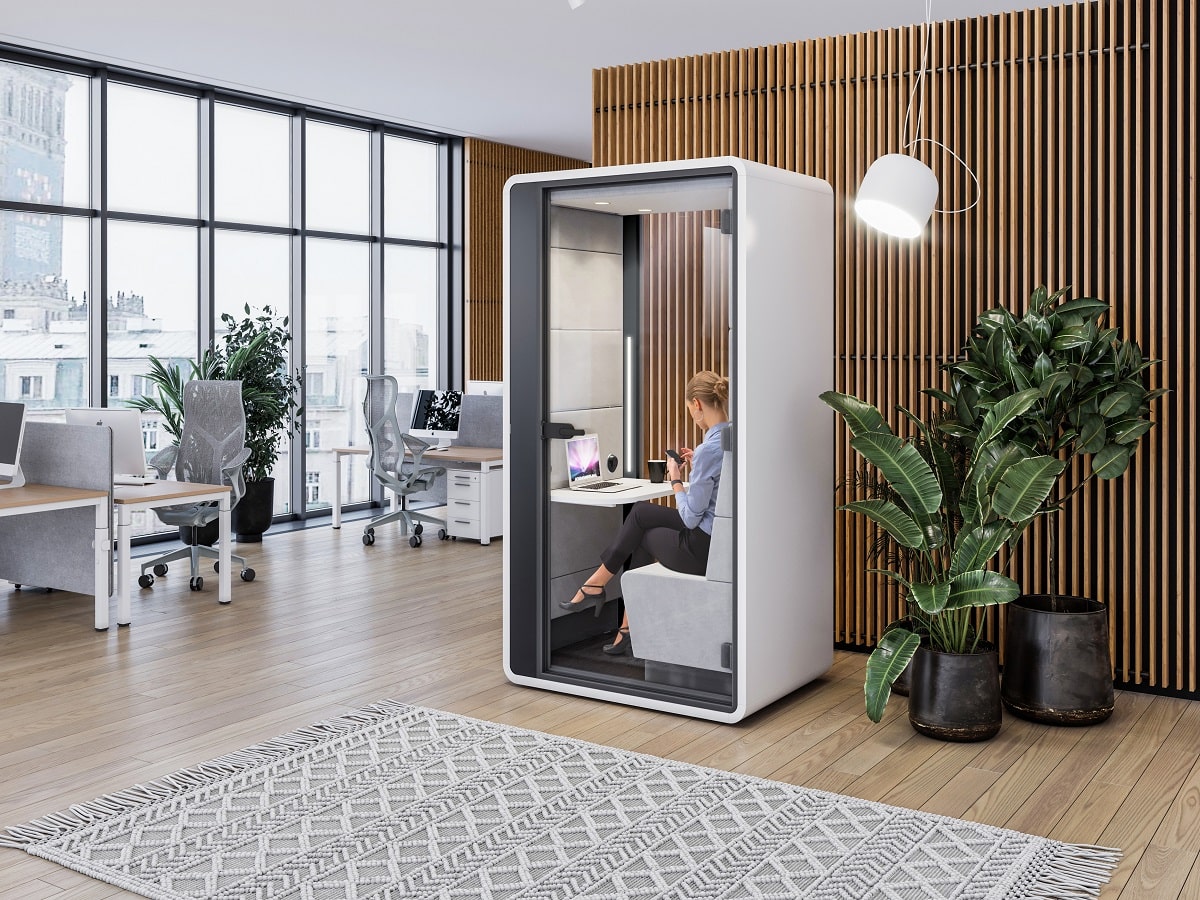
The common sources of sound interference in the office…
From blatant culprits like nearby phone calls to subtler thieves of progress, like droning air conditioning units. The big instruments in workplace noise take many timbres and volumes but, altogether, rob employees of coherent, productive thought.
Conversations. Overheard speech is one of the most distracting sounds in an office environment. This is because intelligible speech reduces cognitive performance, as the brain is naturally inclined to process language, making speech hard to ignore.
Rings, pings, and the like. Sudden and intermittent sounds like device notifications are exceptionally good at breaking concentration and inducing stress. Such sounds are of course startling and highly likely to add to mental fatigue, decreasing work performance, all the while crippling the employee’s mood.
Office machines and systems. Noise from printers, copiers, and HVAC units can blend into a constant, low-level white noise that adds to an employee’s mental load and stress depending on its volume.
Environmental noise. External sounds like traffic and construction must be factored into your office’s acoustics plan. After penetrating a building, they become part of the interior. Indeed, prolonged exposure to high levels of environmental noise can actually lead to adverse health effects like cardiovascular issues and sleep disturbances.
Balancing collaboration with the need for silence requires care and vision.
Sound is physiological, impacting the body just as it does the mind. Moreover, a given sound’s impact will differ from person to person, since we are all wired and tempered uniquely to various noise qualities and levels. So a highly detailed focus in pursuit of better acoustics is critical.
What exactly is the office soundscape?
An office’s soundscape is the special auditory environment created by its fusion of ambient, human, electronic, and environmental sounds. Think of it as the workplace’s soundtrack. It considerably impacts employee mood and cognitive capacity, in a similar fashion to music.
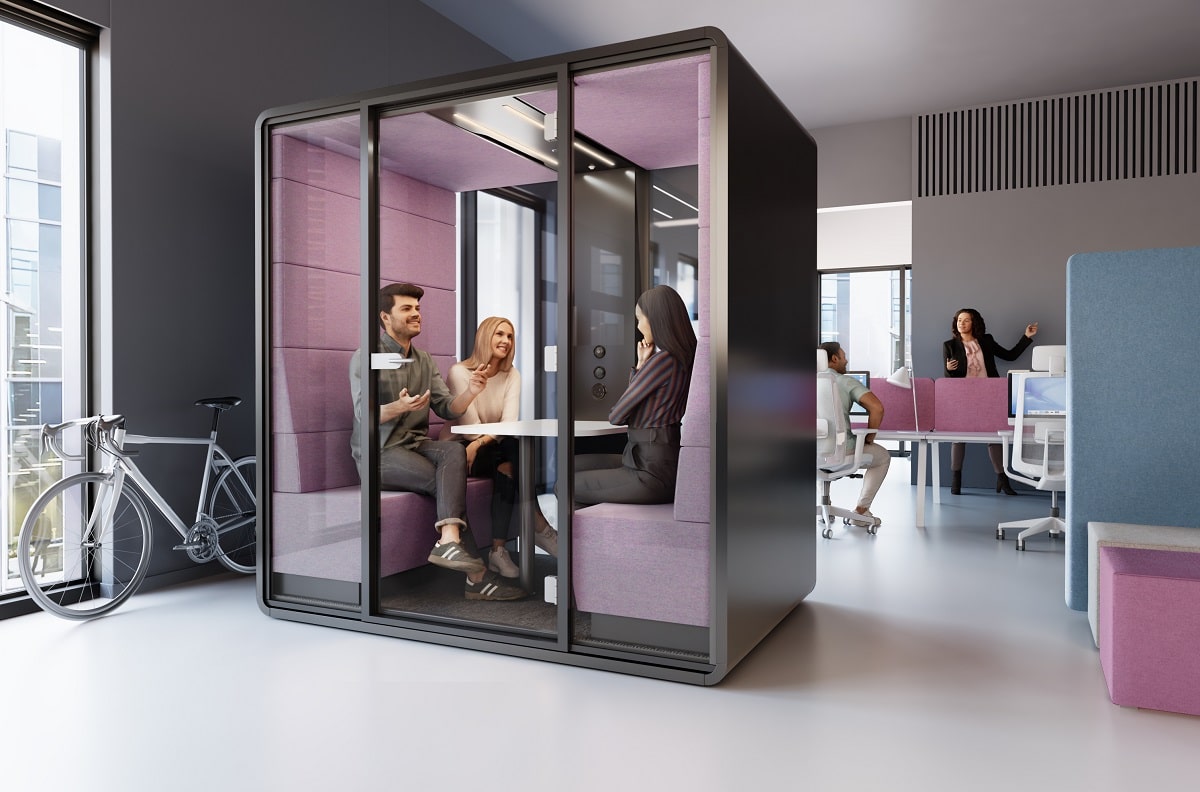
The low thrum of air conditioning mingling with tinny keyboard clatter. And interspersed with bursts of conversation. The occasional trill of a phone. This complex tapestry profoundly decides employee performance and health. Finding the right balance is of course of the essence. Too much noise breaks concentration. But a stark silent office feels odd and isolating to the typical employee. Thoughtful fixes like soundproofing, white noise machines, meeting booths like hushMeet, and the divvying out of designated quiet zones can transform a jarring office tune into a concordant one of well-blended collaborative and independent efforts. By curating a pleasant ‘office soundtrack,’ companies refine the overall work experience, making the workplace itself more than just a place to work, but a place where creativity is both born and nurtured
– says Mateusz Barczyk, Senior Brand Manager, Hushoffice.
Environmental noise? Eliminate sound penetration from outside the building first.
Stopping sound from entering your space is a first step toward a quieter office for many. Try treating windows with a secondary glaze, soundproof weatherstripping, and employing acoustic panels or mass-loaded vinyl on walls and ceilings. Outdoor barriers like fences and landscaping will also help.
Next, insulate unwanted noises made within the office.
Techniques here include acoustic panels, ceiling tiles, and carpets that absorb sound waves and reduce resonance. Hard surfaces should be treated with soft, dampening solutions where possible. White noise machines can also help. Acoustic work booths like hushHybrid will also help.
Audio diffusion is an excellent finishing touch.
Diffusers are aesthetic surfaces that break up acoustic signals, dispersing them in several directions, creating a hush. By limiting echo and reverberation, they can also improve speech clarity. Properly positioned, these clever panels can be the pièce de résistance for your office’s soundscape.
Office acoustic design — be the conductor of your workplace’s “feeling.”
Beyond mere noise reduction, soundscaping the office means manipulating its sound levels, materials, and spatial arrangements to influence the ambiance and success of your space.

A real and ideal soundscape for work and relaxation?
The field of psychoacoustics gives awesome insight into office acoustics. It indicates that the soundscape most supportive of both focused effort and relaxation features an even mix of biophilic noises, moderate background buzz, and something called controlled variability.
Natural sounds. Sounds from nature — flowing water, rustling leaves, birdsong — can significantly aid relaxation, bettering performance. These familiar “tunes” have a calming effect on the brain and can improve mood and well-being in general. Easier than designing an indoor fountain, one way to tap into biophilia immediately via sound is to encourage the use of private booths like hushHybrid for virtual nature breaks, proven to bring these natural benefits.
Steady background noise. A moderate level of consistent background noise, such as white noise or pink noise, can mask sudden, disruptive sounds. This creates a stable auditory environment that supports concentration and reduces the likelihood of interruption.
Controlled variability. While consistency is important, some degree of variability in our sound environment prevents monotony, helping to keep employees engaged. This universal human desire for variety — for subtle changes in surrounding sound patterns for instance — makes a good case for creating pop-up workspaces near the office’s more social zones where employees can get lost in thought amidst coffee-shop-esque bustle.
A conducive acoustic landscape features beneficial sound without noise.
How to differentiate between the two? Often the answer is clear. When this isn’t the case, try writing drown the discrete noises that play out in your workplace in a week and analyze each noise’s context, frequency, intensity, and duration for a clear picture on the overall soundscape.

Absolute silence is as undesirable as excessive noise.
Extremely quiet environments make sudden noises more jarring. On the other hand, blaring atmospheres are overwhelming and stressful. So a temperate sound level is, broadly speaking, the most comfortable and, thus, conducive to peaceful work.
Norms and standards for workplace acoustics worth knowing.
For an overview, take a look through the U.S. Green Building Council’s latest LEED parameters for acoustic comfort parameters or the International WELL Building Institute’s “The WELL Sound concept” guidelines. Both will give you a solid grasp on workplace acoustics.
So how can a suitable soundscape be achieved in the workplace?
After handling environmental noise from outside, insulating noise made within, and employing diffusers throughout, perfecting the office’s “music” becomes a matter of balancing open with closed spaces via zoning. As the cherry on top, this makes for, ultimately, a most individualized treatment.
Openness tempered against privacy is critical.
Today’s employee wants autonomy. Control over where, when, and how they work. And this preference regards work acoustics — people seek access to a variety of soundscapes. Access to speech privacy for calls, hubbub for creative work, and quietude for concentrative efforts as needed.
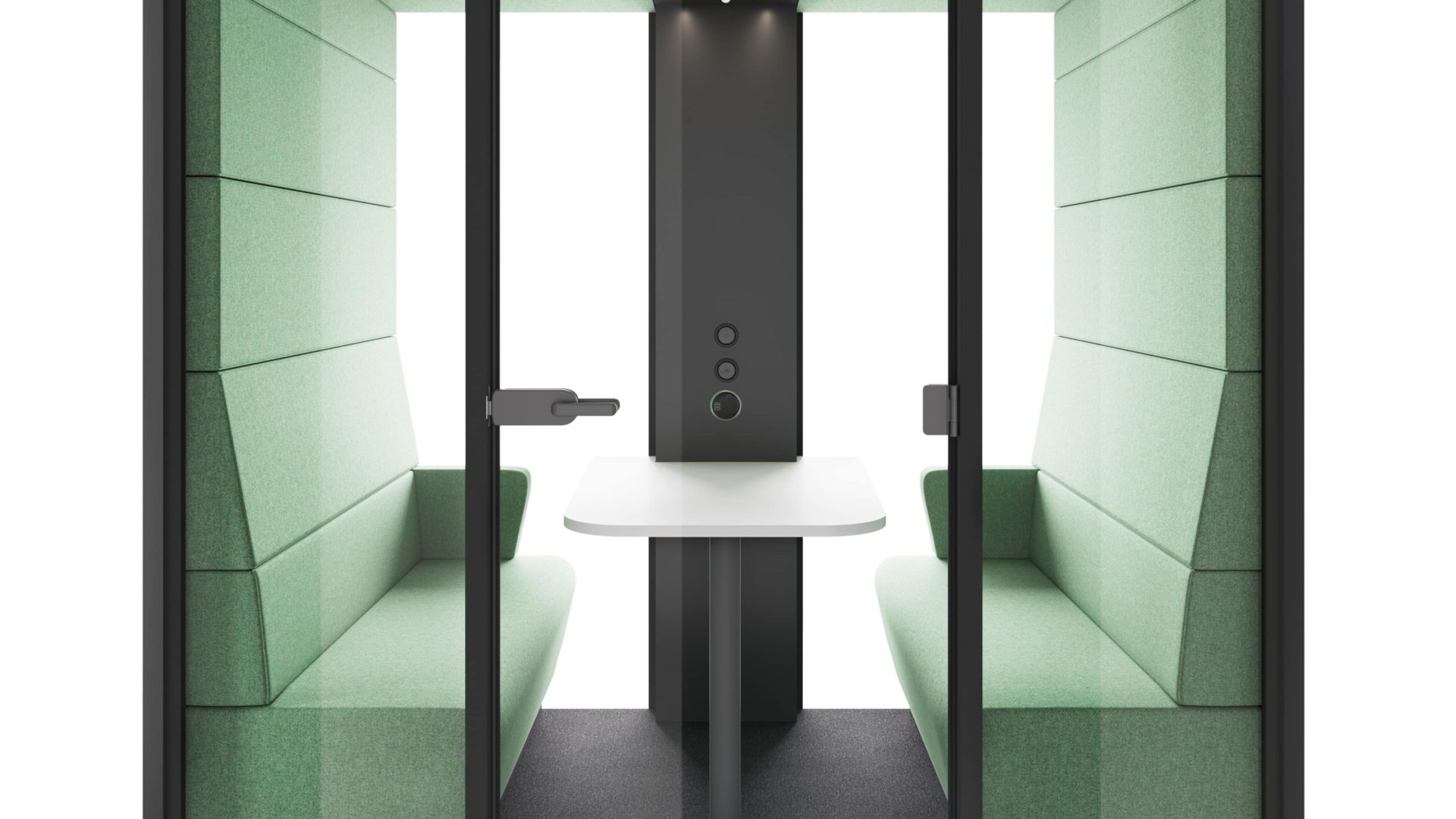
Hushoffice acoustic cabins — an integral piece of the office acoustics puzzle.
Hushoffice is a line of acoustic office pods that better any open space’s soundscape. They guarantee speech privacy, giving employees more discretion. Their adjustable lighting and ventilation afford comfort. And they are fully mobile, for great flexibility.
Noteworthy technology to support acoustic balance in the office…
Several newer technologies are enhancing office acoustics by addressing noise control, sound masking, and acoustic management more effectively.
There are innumerable technologies to support better sound in work environments. ANC systems, for instance — advanced algorithms and mics detecting unwanted noise to cancel it out. Or adaptive sound masking systems. These systems dynamically adjust the level of background sound based on the ambient noise levels. Acoustic metamaterials are another cool one. These are finely engineered with special properties that manipulate sound waves most efficiently. Then, of course, acoustic office booths like our Hushoffice line — brilliantly soundproofed and comfortably equipped with every feature needed for convenient working. All in all, things are looking up for the open office’s acoustics
– says Mateusz Barczyk, Senior Brand Manager, Hushoffice.
Office soundscape – summary
Sound is integral to an office’s ergonomics, or the ease it affords employees while they perform each day. The psychoacoustics field indicates that soundscapes best promoting a mix of focused effort and mindful relaxation are partly biophilic, with a relatively steady background level, and some variability.
Most simply, the first step in improving a workplace’s acoustics is eliminating the noise that penetrates from outside. Here, treatments like secondary window glazes and sound-buffering landscaping are suited. Second comes the insulation of sounds made within. Solutions like noise-absorbing panels and upholsteries help on this front. Lastly, sound diffusers are a smart third step for teams who want to break up excess sound in select parts of the layout.
Office booths like the Hushoffice line are an awesome option for open spaces because they are self-contained work and meeting environments. Meticulously designed to give employees a premium, pleasantly quiet interior, they make deep focus and attentive collaboration more easily found on open floors. Moreover, they dampen all speech made within, sparing the floor, at large, of interruptive noises.
Office soundscape – frequently asked questions
How do I stop sound from entering my office building?
You can implement several measures such as installing soundproof windows and doors, using dense insulation materials in walls and ceilings, adding weatherstripping to seal gaps, applying acoustic panels, and incorporating mass-loaded vinyl barriers. Additionally, consider using soundproof curtains and secondary glazing. Lastly, ensure that any openings or vents are treated with acoustic sealant to minimize sound infiltration.
What is an office sound diffuser?
This is a device or material designed to scatter sound waves evenly across a space, rather than allowing them to reflect directly off surfaces. This helps to reduce echoes and reverberations, creating a more balanced, pleasant acoustic environment.
How can I improve my open office’s acoustics?
First, address external environmental noise. Then insulate internal disturbances. Lastly, consider strategically placing diffusers throughout the space. From there on out, perfecting the office’s ambient sound involves creating zones that balance open and closed spaces. This ensures a highly personalized and effective work environment. For an all-in-one approach, look into large conference booths like hushAccess.L which greatly cut down on collaborative racket in an office space while giving employees that personalized workspace.

